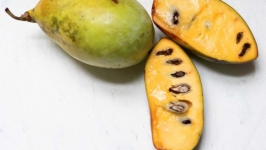Restorative Summer Foods
Restorative Summer Foods
As a long-time professor of multiple college courses including nutrition and holistic health, I am keenly aware of the foundational role that healthy food plays in maintaining optimal wellness. In addition to the basic nutrients found in foods to form a platform for good health, specific nutrients have been found to offer definite benefits in supporting vitality. From this knowledge as a professor and my upbringing and background in horticulture, I value summer as a magnificent time for enjoying fresh, restorative foods. Here are a few of my favorites:
Fruits
According to research, fruits can contribute substantially to good health given that they provide an array of essential vitamins, minerals and fiber, as well as an abundance of antioxidants and phytonutrients. Antioxidants combat free radicals associated with toxins and everyday “wear and tear” that can contribute to dysfunction in the body. Fortunately, researchers continue to find additional antioxidants in fruit year after year.
While all fruits are beneficial, berries “top the list” as being some of the healthiest fruits available. Blueberries, blackberries, loganberries, raspberries, mulberries, elderberries, strawberries and goji berries all provide nutrients that have been credited with improved cardiovascular, immune and nervous system health, offering particular value in benefitting eyesight, combatting viruses and in preventing oxidation of cholesterol and heavy metals.
Currants and cherries are also nutrient-dense options, high in the antioxidant vitamins C and A, plus an easily absorbable form of the mineral, iron. Like many of the berries, currants and cherries also contain antioxidants from the anthocyanin family, recognized for reducing inflammation in the body and boosting immunity. Moreover, currant seeds contain gamma linoleic acid, an essential fatty acid also used to treat inflammatory conditions, and their leaves can be used to make a pleasant tea.
Avocados are another fruit with noteworthy nutrients, including essential amino acids, the “building-blocks” of proteins, plus yielding one of the highest fruit-based sources of the trace mineral zinc, central to hundreds of functions in the body including cellular communication.
Vegetables
Vegetables also offer substantial health benefits, particularly leafy greens. Prized for their high vitamin and mineral content, leafy greens also provide important amino acids, plus fiber, antioxidants and essential fatty acids. Minerals are a critical component of human health, and while minerals are readily found in solid matter, in this unrefined form, the body struggles to assimilate them. Plants, however, transform minerals into a more easily usable form, with leafy greens providing key sources. Like fruits, leafy greens likewise help alkalize the body, benefitting overall somatic functioning through regulation of pH. Leafy greens such as spinach—along with its even-healthier cousin lambs quarters—provide valuable sources of vitamins B6 and B9, which play an integral part in the body’s methylation chain, crucial to supporting cardiovascular, metabolic and neurologic health as well as cellular regeneration.
Leafy greens also provide potassium and magnesium for cardiovascular health, vitamins A and C to support immunity, plus key nutrients important in bone health, including a readily useable form of calcium along with vitamin K; prime examples include collards, nettle leaves and dandelion greens. Kale, turnip greens, mustard greens, arugula and watercress are all rich in vitamins and minerals including iron, and are specifically prized for their health-protective nutrients such as immune-boosting isothiocyanates and sulforaphanes, plus anti-inflammatory and anti-microbial alkaloids. Spinach, along with beets, also provides betaine, a methyl-donating nutrient credited with protecting cells from environmental stress. Leafy greens such as romaine and butter lettuce also contain vitamin E and essential fatty acids (EFAs), with purslane offering one of the highest land-based sources of Omega-3 EFAs. Research shows that dietary intake of antioxidants— especially the carotenoid-nutrients lutein and zeaxanthin—improves visual function and reduces the risk of age-related macular degeneration. Lutein is found in most dark leafy greens while zeaxanthin is particularly high in orange peppers, goji berries, corn and egg yolks, and the combination of lutein and zeaxanthin can be found in spinach, collards, turnip greens, kale and romaine lettuce, as well as in zucchini and kiwi.
Herbs & Flowers
Herbs represent another treasure from the summer garden, reliably including concentrated sources of nutrients. The leaves of basil, cilantro, mint, oregano, parsley, sage and thyme are just a few examples, and the flowers of these herbs can also be consumed for additional flavor and nutritional benefit. The flowers of leafy greens such as arugula and chives are also nutritious options, lending a robust taste to summer fare. The peppery flowers of nasturtium contain vision-boosting lutein, and calendula flowers contain high sources of both lutein and zeaxanthin; the petals can be eaten raw, or dried and used in a tea or as an economical alternative to saffron. Daylilies are also edible, and sunflowers yield both edible petals as well as “chokes” that are somewhat similar to artichokes.
Many additional summer foods also offer tremendous health benefits. Carrots are a great source of cardiovascular and vision-benefitting carotenoids while containing a highly absorbable form of calcium. Onions contain powerful anti-inflammatory and immune-boosting compounds plus quercetin, a natural anti-histamine that helps relieve symptoms of allergy. Celery is another donator of vital, easily absorbed minerals. The list of healthy summer foods is truly extensive.
To find farmers markets near you that offer these foods, enter your town or zip code on Local Harvest. If you are interested in learning more about the information presented in this article, please contact me.
Enjoy your summer knowing the fall season will likewise bring its own unique harvest of restorative foods.









